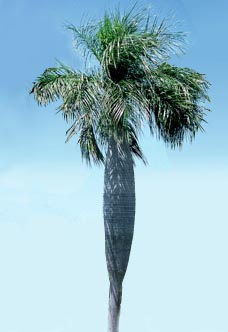Acrocomia crispa Informationen
A solitary, tall, drought tolerant, alkaline soil tolerant, moderately slow growing, monoecious palm. Rare in cultivation, locally common in the wild. It has a spiny, grey trunk, 18.3 m. (60 ft.) tall, 20-46 cm. (8-18 inch) diameter with spaced ring leaf scars, and large segmented, pinnate (feather) leaves, 3 m. (10 ft.) long, 1.5 m. (5 ft.) wide, dark green above and, greyish green beneath.
This is the Cuban Belly Palm from Cuba, Gastrococos crispa, which has recently changed its name. It is a tall, spiny palm with a trunk that is slender at the base, but swollen in the middle, giving it the name "Cuban belly palm" in English. Locally common on calcareous soils within Semi-deciduous forest, Degraded scrub, and Savanna in Cuba.
Acrocomia crispa can tolerate close to freezing conditions. But low temperatures are best avoided, it will not tolerate any duration of dormancy and anything other than the briefest of cold snaps will surely kill a young plant. It naturally occurs in dry, arid, sun exposed, grassland locations, and should be planted to maximise Summer heat & sunshine exposure. Its roots will travel down to find water. Under cold conditions we recommend you keep this palm as dry as possible, which will usually mean constructing a glass or plastic roof over the plant to keep rain off, and supplemental heat provided over duration. Any cover placed over this palm during times of rain or during cold nights must be removed or vented during hours of sunshine or the plant could be severely heat stressed.
Allgemeine Informationen:
Recent DNA studies between Gastrococos crispa and Acrocomia aculeata, show they differ by only two base pair positions (Gunn, 2004). These two taxa are vegetatively similar differing primarily in floral arrangement, morphology, and pollen size (Gunn, 2004). These phylogenetic results changed the status of the Caribbean Island endemic genus Gastrococos to be part of the more widely distributed Acrocomia, this latter was first proposed by von Martius (1824) who described a single species from the West Indies (A. aculeata). Furthermore, based on morphological characters, Beccari (1912) had previously recognized Acrocomia crispa on his treatment to the palms indigenous to Cuba.
Verteilung:
Heimisch in, Cuba

